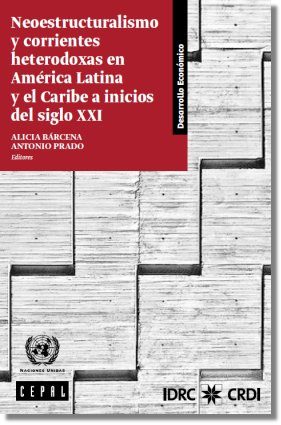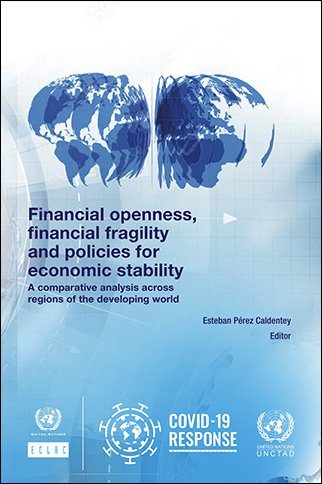Publisher: Third World Network Year: 2023 No. of pages: 42 Download now About the Book…
Neo-Structuralism and Heterodox Currents in Latin America and the Caribbean at the Beginning of the XXI Century Edited by: Alicia Bárcena and Antonio Prado

Publisher: The United Nations
ISBN: 978-92-1-121879-4 (versión impresa y pdf)
ISBN: 978-92-1-057093-0 (versión ePub)
About the Book
This book, edited by the Executive Secretary (Alicia Bárcena) and Deputy Executive Secretary (Antonio Prado) of the Economic Commission for Latin America and the Caribbean (ECLAC, Chile), explores and examines the spaces for dialogue and collaboration between Structuralism/Neo-Structuralism and heterodox currents of thought with a focus on Latin America and the Caribbean.
This effort is a basis to articulate a policy agenda alternative to that of mainstream economics. The book is available in Spanish (for the time being) and can be downloaded freely (available in pdf). The following sections provide the context, motivation and main themes found in the text.
In the past few years, mainstream economic thinking which has dominated the teaching of economics and economic policy since the second half of the XXth Century, has been the object of strong criticism and the subject of a heated debate involving mainstream and non-mainstream economists regarding its conceptual and empirical coherence and validity. The current state of dissatisfaction with the mainstream has a definite reference point: the failure of the profession to foresee any potential imbalance that could result in a crisis of the magnitude of the Global Financial Crisis (2007-2009), let alone predict its protracted effects on output and employment. More importantly, the majority of economists recommended and hailed precisely the type of policies that led to the Global Financial Crisis.
The on-going Euro-Crisis (2009-2015), the virtual crash in the commodities markets at the end of 2014 and beginning of 2015, and the generalized slowdown in growth provide further proof of the limitations of the dominant paradigm in economics to take on board the fundamental economic problems of our time. Following the thought of John Maynard Keynes and Raúl Prebisch, these can be summarized as the failure of free market oriented economies to provide full employment and the creation of decent jobs as a norm, their tendency towards the arbitrary distribution of income and wealth, and their propensity towards financial fragility and instability.
These problems are not the result of exogenous factors or external shocks. Contrarily, they are endogenous to the workings of both developed and developing economies.
In the case of Latin America and the Caribbean, these problems are associated to structural characteristics of Latin America and the Caribbean that were highlighted more than half a century ago by Structuralism. Structuralism was developed and articulated in the 1950s and 1960s following the thinking of a group of economists mostly based in ECLAC. Famous structuralists include Celso Furtado (1920-2004), William Arthur Lewis (1915-1991), Raúl Prebisch (1901-1986), Juan Noyola Vázquez (1922-1962); Aníbal Pinto Santa Cruz (1919-1996); Osvaldo Sunkel (1929-) and Ignacio Rangel (1914-1994).
Structuralist thought emerged as a response to the development problems of Latin America and the Caribbean at the time, and the dissatisfaction with orthodox diagnoses. Structuralists viewed underdevelopment as an intrinsic feature of Latin America and the Caribbean ingrained in its own social and economic structure and their views sought to provide an intellectual framework to understand that reality. In this sense Structuralism ‘was a practice, before being a policy and a policy prior to becoming a theory.’
The structural obstacles and stumbling blocks to the economic and social development of included, among others, the lag in technological progress, the external restriction, structural heterogeneity, instability of real variables, the political economy of dependency and power relations articulated under the dual concept of center-periphery. According to C. Furtado, Structuralism is the only effort of creation of a body of thought on economic policy that has emerged within the developing world.
Structuralism did not develop in isolation from other critical currents of its time. It actually benefitted from the intellectual exchanges and influence of some of the major thinkers in economics such as John Maynard Keynes (1883-1946), Roy Harrod (1900-1978), Nicholas Kaldor (1908-1986), Michael Kalecki (1899-1970) and Joseph Aloys Schumpeter (1883-1950).
Within this group, Kaldor was the closest to Latin America, Structuralism and ECLAC. In 1956, upon the recommendation of Raúl Prebisch, who directed ECLAC at the time, Kaldor prepared the study, The Economic Problems of Chile focusing on inequality and defending a Structuralist interpretation of inflation. Kaldor was not only impressed by the analysis of inflation developed at ECLAC by Noyola and Sunkel, but also developed during his lectures in Chile and Brazil a series of concepts, some of which, would dominate his thinking including cumulative causation, technical progress and the limits to industrial growth. Later on, in his many visits to Mexico, he focused on an exchange rate strategy and framework to promote economic development.
After period of loss of visibility associated with the 1980s Debt Crisis and lost decade, and the rise to prominence of the now defunct ‘Washington Consensus’ and its mantra, ‘stabilize, liberalize and privatize’, the ideas of Structuralism were recovered and adapted to the reigning economic conditions at the time by Neo-Structuralism. Neo-Structuralism developed from ECLAC’s document Changing production patterns with social equity: the prime task of Latin American and Caribbean development in the 1990s (1990) (http://repositorio.cepal.org/handle/11362/37869?show=full) largely inspired by Fernando Fajnzylber, which continues to guide the most recent documents of ECLAC such as Structural Change for Equality (2012) and the work of renown Latin American economists such as Ricardo Ffrench Davis and José Antonio Ocampo.
Neo-Structuralism shares the same methodological principles and views of Structuralism and constitutes an effort to confront the modern development problems faced by Latin America and the Caribbean, including how to deal with the consequences of greater liberalization in trade and finance, to overcome productive heterogeneity, and improve income distribution.
Moreover, Neo-Structuralism sustains, in line with heterodox thinking, that there is no theoretical or empirical foundation to argue that free markets can allocate goods and services in order to optimize economic and social welfare. Neo-Structuralism argues that a strong state and government is essential to improve the capabilities and well being of a society. Developing countries need to overcome some of the major endogenous obstacles to their development including, low and volatile growth, low productivity, and unequal distribution of income, through active government efforts in education, health, redistributive policies and industrial policy among others.
Both Neo-Structuralism and Structuralism are open systems. They are not self-contained systems of thought. They analyze the behaviour of economic agents and social and economic structures and their interrelation within a given historical and evolutionary context. This implies that there is no complete knowledge of all variables that are included in the analysis nor of all their interrelations. The nature of variables (i.e. exogeneity/endogeneity) can change over time and the interrelation between agents and between agents and economic structures are interdependent and change over time. The open system feature of Neo-Structuralism and Structuralism, as well as some of its core features described above, are shared by heterodox and pluralist approaches including, Marxist, post-Keynesian, evolutionary and institutional approaches.
The creation of spaces for dialogue between Structuralism/Neo-Structuralism and the collaboration between Structuralism/Neo-Structuralism and heterodox currents of thought is precisely the ultimate objective of this book. The book also stresses how the intellectual collaboration between these different approaches can lead to a policy agenda that is an alternative to that espoused by mainstream economists.
The fifteen essays included in the book are divided into four sections: the New Realities and the Regional and Global Level after the Crisis; Macroeconomics for a New Development; Productivity and Structural Change, and the State and the State and Society in the Development of the XXI Century.
A close reading of these chapters will reveal the commonalities between the Structuralist/Neo-Structuralist and heterodox traditions, identify similar points of views and establish future research agendas. To be more precise a common research agenda can be established around seven topics (i) a methodological approach based on historical trends and measurement; (ii) the characterization of the system of economic relations around the concepts of center and periphery; (iii) the relation between income distribution, accumulation and economic growth; (iv) volatility and instability; (iv) technical progress and innovation; (vi) the relationship between the short and long-run; and (vii) the role of the State.



